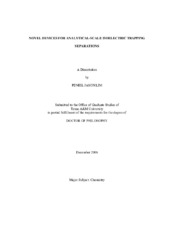| dc.description.abstract | Isoelectric trapping (IET), has proven to be one of the most successful electrophoretic techniques used for separations of ampholytic compounds. IET is carried out in multicompartment electrolyzers (MCEs) in which adjacent compartments are joined through buffering membranes whose pH values bracket the pI of the ampholytic component to be trapped in the compartment. The present small-scale instruments use plastics as their structural materials, which causes poor Joule heat dissipation. The separation compartments have cylindrical or pear-shaped interiors with large internal diameters, which create long heat transfer paths. The long electrode distances yield low field strengths that lead to low electrophoretic velocities for the analytes. These factors interrelatedly limit the electric power that can be applied to the system, contributing to long separation times. Furthermore, these devices do not offer a realistic solution to the problems associated with the detection of low abundance proteins. To address these problems, two novel IET devices have been developed for small-scale IET separations. The first device, named MSWIFT, was constructed using thermally conductive, high-purity alumina as the structural material of the separation compartments. By creating narrow, 0.1- or 0.2-mL channels in thin alumina blocks, the heat transfer path from the center of the compartment to the wall was significantly decreased; and the distance between electrodes was greatly shortened. MSWIFT achieved 6 to 50 times faster IET separations compared to other MCEs. The second device, named ConFrac, was developed to simultaneously fractionate and concentrate ampholytic components from a complex sample into 0.1-mL collection compartments. By designing a system with a 2-dimensional pH gradient and allowing recirculation of the sample feed, the ConFrac demonstrated enrichment of analytes by a factor of 100 and greater. | en |


